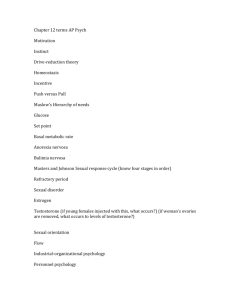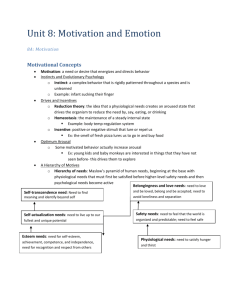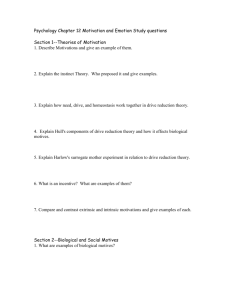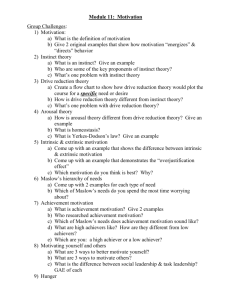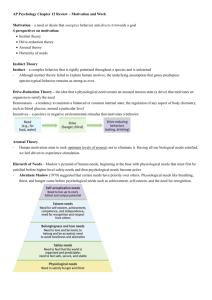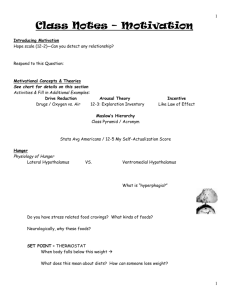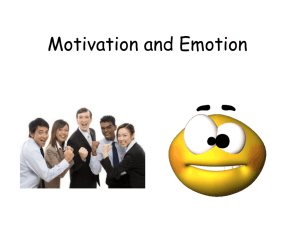Hunger, Sex, Social Motivation
advertisement
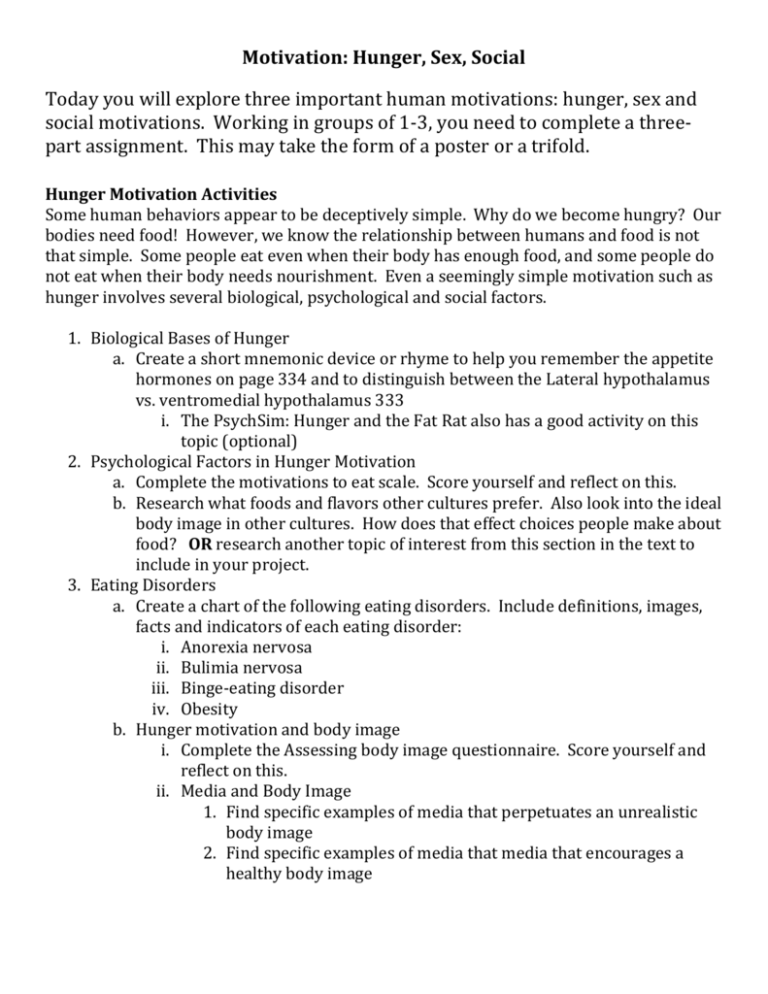
Motivation: Hunger, Sex, Social Today you will explore three important human motivations: hunger, sex and social motivations. Working in groups of 1-3, you need to complete a threepart assignment. This may take the form of a poster or a trifold. Hunger Motivation Activities Some human behaviors appear to be deceptively simple. Why do we become hungry? Our bodies need food! However, we know the relationship between humans and food is not that simple. Some people eat even when their body has enough food, and some people do not eat when their body needs nourishment. Even a seemingly simple motivation such as hunger involves several biological, psychological and social factors. 1. Biological Bases of Hunger a. Create a short mnemonic device or rhyme to help you remember the appetite hormones on page 334 and to distinguish between the Lateral hypothalamus vs. ventromedial hypothalamus 333 i. The PsychSim: Hunger and the Fat Rat also has a good activity on this topic (optional) 2. Psychological Factors in Hunger Motivation a. Complete the motivations to eat scale. Score yourself and reflect on this. b. Research what foods and flavors other cultures prefer. Also look into the ideal body image in other cultures. How does that effect choices people make about food? OR research another topic of interest from this section in the text to include in your project. 3. Eating Disorders a. Create a chart of the following eating disorders. Include definitions, images, facts and indicators of each eating disorder: i. Anorexia nervosa ii. Bulimia nervosa iii. Binge-eating disorder iv. Obesity b. Hunger motivation and body image i. Complete the Assessing body image questionnaire. Score yourself and reflect on this. ii. Media and Body Image 1. Find specific examples of media that perpetuates an unrealistic body image 2. Find specific examples of media that media that encourages a healthy body image Sexual Motivation Activities Sexual motivations are vital for the continuation of any species. One of the primary tasks for most living organisms is reproduction. Since humans are one of the most complex living organisms, our sexual motivations are correspondingly complex. Like hunger, sex is motivated by both biological and psychological factors. 1. Sexual Response Cycle/Biological Factors: a. Create an informational flowchart of the sexual response cycle. Do not draw pictures! Just explain each stage in a visual flowchart. b. Research the onset of puberty in adolescence. How has it changed in the last 100 years? Why? Explain the effects of this OR research another topic of interest from this section in the text to include in your project. 2. Social Factors in Sexual Motivation: a. Research statistics about teen pregnancy in the USA, Colorado and locally. Is teen pregnancy becoming more or less prevalent? Why do you think this is? OR b. Media and Sex: How does the media effect teen attitudes toward sex? i. Do you think the Media encourages healthy attitudes toward teenage sexuality? 3. Sexual Orientation: a. Use your textbook/the internet to look into the following: i. What causes differing sexual orientations? ii. Use your book and the internet to collect 5-10 facts and statistics about sexual orientation iii. Define: Lesbian, gay, bisexual, transgendered, questioning iv. How has the perception of LGBTQ people evolved in the last 50 years? Social Motivation Activities So far, you have looked at some relatively simple human behaviors like eating and sex. What motivates the more complex behaviors? Your attitudes and goals, the society you live in and the people you surround yourself with also affect what you are motivated to do. 1. Complete the Fear of Negative Evaluation Scale. Score yourself and reflect on this 2. Storyboard each section in the text for social motivation/need to belong (pp. 359362). For each section, draw an image/scene and provide a caption that explains your picture and summarizes important points from the reading: a. Aiding survival b. Wanting to belong c. Sustaining relationships d. The pain of ostracism
